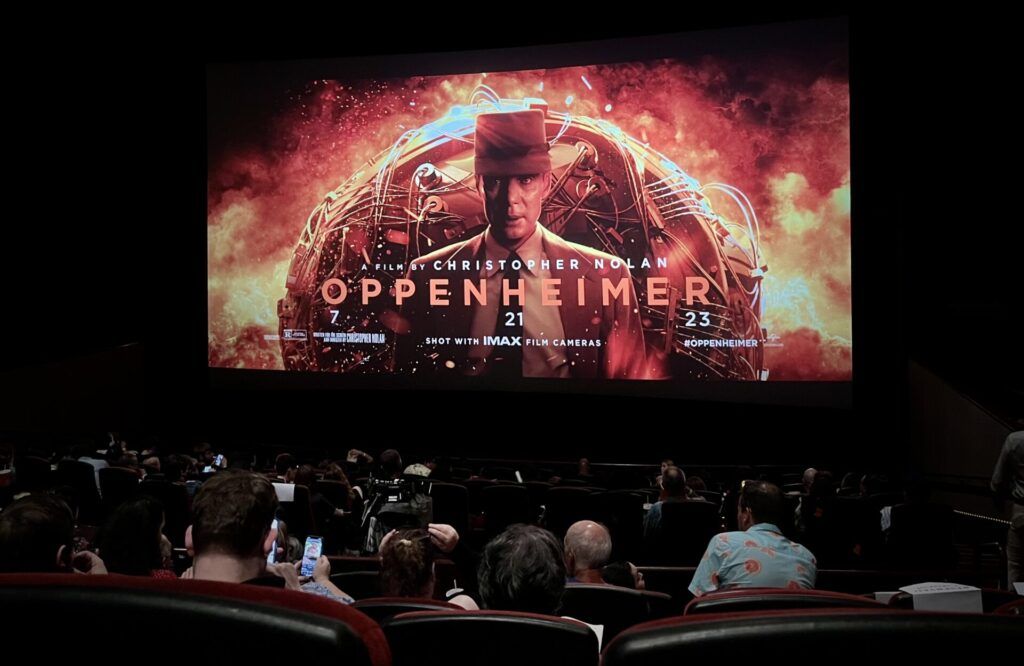The Bulletin reviews ‘Oppenheimer’
By Thomas Gaulkin | July 21, 2023
 Cillian Murphy stars in Christopher Nolan's “Oppenheimer”, a prismatic psychological study of the "father of the atomic bomb." (Universal Pictures)
Cillian Murphy stars in Christopher Nolan's “Oppenheimer”, a prismatic psychological study of the "father of the atomic bomb." (Universal Pictures)
Writing about Christopher Nolan’s “Oppenheimer” for the Bulletin of the Atomic Scientists requires a few disclosures first. The history of the Bulletin is inseparable from the history of the making of the nuclear bomb, not least because J. Robert Oppenheimer himself was the first chair of the Bulletin’s Board of Sponsors. Many of the other key scientific figures depicted in the film served as early sponsors of the Bulletin, too (including Albert Einstein and Edward Teller) or were contributors.
“Oppenheimer” is one of the most anticipated movies of the year, and deservedly so. It’s a stunning new approach to historical drama. It’s a film fugue that perfectly matches Nolan’s talent for non-linear narrative with a colossal, decades-long tale of strange new physics and equally enigmatic personalities. It’s a biopic disguised as an action thriller, or the other way around.
For the first half of the film, Oppenheimer (played by Cillian Murphy) seems to have a date with destiny, as scenes careen through meetings with scientists, policy debates, security hearings, and intimate closeups, all leading toward the inevitable test of the bomb on July 16, 1945.
It’s a very talky picture, but it stays engrossing—in three hours of conference room and laboratory interiors, things rarely seem to drag. If anything, the film (expertly edited by Jennifer Lame) sets off at a bewildering pace, sometimes introducing new people into Oppenheimer’s orbit every few seconds. The action jumps throughout between color scenes from Oppenheimer’s perspective to black-and-white scenes centered on Lewis Strauss (Robert Downey Jr)—Strauss was chairman of the Atomic Energy Commission in 1954 when Oppenheimer’s purported Communist sympathies prompted a hearing that ultimately stripped him of his government security clearance (a decision reversed by the Department of Energy last year). Those events are the fulcrum on which Nolan’s intricate chronology turns.
It’s hard to keep up, but that’s probably the idea—by the time Oppenheimer takes over the Manhattan Project, everyone watching the movie is already part of the race to build the Bomb.
It’s no small achievement to condense a three-hour feature out of the 700-page tome the movie is based on, American Prometheus: The Triumph and Tragedy of J. Robert Oppenheimer, by Kai Bird and Martin Sherwin (not to mention that the Manhattan Project itself has become its own metaphor for complexity). But Nolan pulls the abridgement off, with an all-star cast and some Hollywood script-writing tricks that help things along. For example, the relationship between Gen. Leslie Groves (the military director of the Manhattan Project, played by Matt Damon) and Oppenheimer occasionally takes things into buddy-movie territory. And Edward Teller (Benny Safdie) gets a Dr. Strangelove treatment that he may deserve. Some well-placed moments of humor also enliven the script, with a slapstick bit in which Oppenheimer repeatedly pushes away an over-eager note-taker, David Hill (one of Enrico Fermi’s associates from the Metallurgical Laboratory at the University of Chicago, played by Rami Malek), nicely setting up his role in a serious turn of events toward the end of the film.

Only 30 theaters worldwide are capable of screening the film in the full-frame IMAX format Nolan and cinematographer Hoyte van Hoytema prefer it to be seen, and at various moments I did wish I could have the full experience. (Though Chicago was the site of the first human-made self-sustaining nuclear chain reaction that made this whole story possible, we can’t seem to keep a proper IMAX theater around.) But even at the standard 70mm screening I attended, there was no question this was great cinema. “A wonderful format for faces,” Nolan told The New York Times. And it is. Nolan only thought of Cillian Murphy to play the lead when he wrote the film, and it’s clear why.
During the most powerful scene of the whole film—more powerful even than the big explosive one you might be thinking of—all of Nolan’s experimental IMAX filmmaking fuses in a vertiginous nightmare that could stand alone as a statement about the horror that the Bomb unleashed on the world. In that moment, aided by the gigantic screen, I felt momentarily nauseated. Around the same time, the soundtrack (scored by Ludwig Göransson) evokes both the Lacrimosa movement from Mozart’s Requiem and the piercing strings from Psycho, a perfect blend of the regretful and ominous.
It’s notable that the longest scenes—when Nolan lets things settle for a moment—are those in which the big moral and political questions are being debated: the decision to use the bomb on civilians, the development of the hydrogen bomb, preventing an arms race, etc. As these scenes repeat across Nolan’s interconnected narrative, Murphy portrays Oppenheimer becoming increasingly detached and diminished as he loses his grip on the nuclear genie he helped unleash. Elsewhere, the film delivers Oppenheimer’s thoughts through a kaleidoscopic medley of words and scenes that are sometimes obviously fictional, and sometimes a hodgepodge of real events. Some are accurate in broad strokes, but not the details. For instance, in the film, Hans Bethe (Gustaf Skarsgård) corrects calculations by Teller that suggest the atmosphere of the entire Earth could be ignited by a nuclear chain reaction. But Bethe himself credited Teller (and his associate Emil Konopinski) with the best calculations proving the impossibility of that “ultimate catastrophe.” It’s an example of some of the forgivable license taken in the movie—Teller’s cantankerousness needs to be preserved to keep the whirling cast of characters coherent.
Those with more expert knowledge of the history and science will doubtless have other things to say about factual faults in the film. Nolan has also been criticized before for his tendency to portray women unimaginatively through male eyes; “Oppenheimer” is no exception, though in this case, Oppenheimer’s perspective is obviously the point. There are other critiques of the movie’s accuracy and completeness that can be made—for instance, the Native American and Hispano communities that populated the areas around Los Alamos and also worked at the lab turn up for only one fleeting moment, when Oppenheimer suggests to a decidedly unsympathetic President Truman that he “give it back to the Indians.”
But “Oppenheimer,” after all, is Nolan’s prismatic psychological study of one man’s personal choices and struggles, not a history of the Bomb. And if audiences can concentrate through the movie’s knotty and breakneck storytelling on its main dilemmas—whether or not building the bomb was the right thing, and how to live with the consequences—then the fragile moral journey that Nolan’s version of Oppenheimer survives will be haunting and illuminating. Nolan’s ability to transport audiences is undeniable. But like Oppenheimer’s own ambiguous end, the destination remains uncertain.
Together, we make the world safer.
The Bulletin elevates expert voices above the noise. But as an independent nonprofit organization, our operations depend on the support of readers like you. Help us continue to deliver quality journalism that holds leaders accountable. Your support of our work at any level is important. In return, we promise our coverage will be understandable, influential, vigilant, solution-oriented, and fair-minded. Together we can make a difference.
Keywords: Christopher Nolan, J. Robert Oppenheimer, Manhattan Project, Trinity test, movie
Topics: Nuclear Weapons















Saw it last night. One of the most mind-blowing movies that I’ve ever watched.
Thank you. The films “main dilemmas—whether or not building the bomb was the right thing, and how to live with the consequences”. Very important to flag that the film carries on the disasterous myth by repeating at a crucial moment… that a million American soldiers lives could be saved by dropping the bomb. This has long been put to rest and disproven, by Japanese scholar, Tsuyoshi Hasegawa, in his 2006 book “Racing the Enemy”. He plumbed Russian archives as well as Japans. Japan was ready to surrender long before the bomb, and we were worried about Russia racing toward Japan.… Read more »
Thank you. I have not yet seen the movie, but is there any reference the intelligence withheld from the US by the British in June 1942, when they had evidence of the cancellation of the uranium bomb project by the Germans? Peter Watson’s recent book ‘Fallout’ looks to be a good update on a earlier book by Arnold Kremish on Paul Rosbaud and German weapons programmes.
Great review. I saw the movie Friday morning on the biggest most sound appropriate theater near me. As a Cal Berkeley Chemistry PhD including some work using equipment at Lawrence Berkeley Laboratory every time a name came up I would search my memory for what that scientist contributed to science. (Graduate work studied the f-orbital bonding in Uranocene a next homologue of Ferrocene)
As I wrote last August, I believe dropping the bombs on Hiroshima and Nagasaki was both a moral and strategic imperative: https://issuesinsights.com/2022/08/04/the-united-states-use-of-nuclear-weapons-77-years-ago-was-a-moral-and-strategic-imperative/.
I saw the movie last Friday. While I understand the overwhelming sound as the bomb is being depicted, the overwhelming background music and sound is so loud it drowns out significant portions of dialogue. Is this really neccesary. I will have to wait the coming months to understand much of the intricacies of the film, until a closed caption version comes out on some “television channel”.
I agree about the poor sound quality especially. The only character who really sounded out was Groves…appropriate, I guess. I feel a second film could focus on the Strauss/AEC madness and done so with more finesse and less confusion. The acting was brilliant. Has there been a (non-documentary) film about the espionage at the Manhattan Project?
I agree. I recently read that due to the way sound is done in modern film a large percentage of people prefer to turn captions on where able. I wear hearing aids and no amount of volume increase can compete with the background noise in these films as most hearing aid wearers can attest to. I loved the movie though frustrated I could not understand a lot of the conversations as it jumped from scene to scene. However, I will not let my hearing get in the way of great movies and actors. Just hope sound is not compromised further… Read more »
The BBC production of Oppenheimer was to me, a supreme summation and accounting of the bomb development, the personal struggles of Oppenheimer, the development of the two devices from physics, ballistics, and chemistry to the final “delivery”. I have not seen this film yet, and I am eager to, but right off the bat, I think the actor portraying General Leslie R. Groves was a gross miscast.
Watched it on IMAC screen regrettably. The blasting sound was unbearable and obscured the dialog. A straightforward documentary for TV would be probably sufficient; naked sex scenes didn’t really enhanced the story in my opinion. I was surprised to see so many women, some of colour attending the lectures on quantum physics. Watching the films made in those days, I had the impression that the American women were mostly seen in the kitchen. Looks like those films were lying!
I saw it today at the brand new EMX screen at the newly opened Emagine theater in Batavia, IL. The largest screen in Illinois, it was magnificent. And even better – it’s in Batavia, hometown and virtually in the shadow of Fermilab, so I know there were some particle physicists in the audience. Not an IMAX (used to be), but still an awesome theater experience. Try it. Great review, helped a lot.